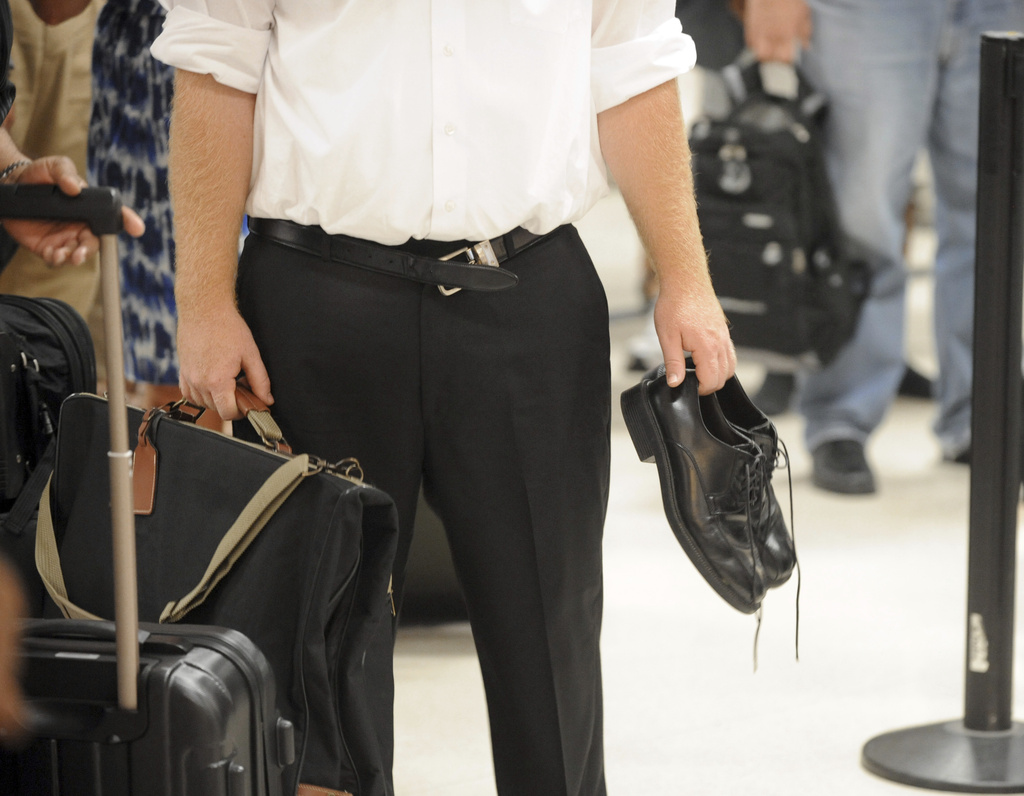Travelers racing to catch a flight at U.S. airports no longer are required to remove their shoes during security screenings, Homeland Security Secretary Kristi Noem said Tuesday.
Noem said the end of the ritual put in place almost 20 years ago was effective nationwide effective immediately. She said a pilot program showed the Transportation Security Administration had the equipment needed to keep airports and aircraft safe while allowing people to keep their shoes on.
“TSA will no longer require travelers to remove their shoes when they go through security checkpoints,” Noem said.
While shoe removal no longer is standard procedure, some travelers still may be asked to take off their footwear “if we think additional layers of screening are necessary,” she added.
Security screening sans shoes became a requirement in 2006, several years after “shoe bomber” Richard Reid’s failed attempt to take down a flight from Paris to Miami in late 2001.
All passengers between the ages of 12 and 75 were required to remove their shoes, which were scanned along with carry-on luggage.
From Homeland Security (official):
WASHINGTON—Homeland Security Secretary Kristi Noem announced a new policy today which will allow passengers traveling through domestic airports to keep their shoes on while passing through security screening at TSA checkpoints.
The new policy will increase hospitality for travelers and streamline the TSA security checkpoint process, leading to lower wait times.
“Ending the ‘Shoes-Off’ policy is the latest effort DHS is implementing to modernize and enhance traveler experience across our nation’s airports,” said Secretary Noem. “We expect this change will drastically decrease passenger wait times at our TSA checkpoints, leading to a more pleasant and efficient passenger experience. As always, security remains our top priority. Thanks to our cutting-edge technological advancements and multi-layered security approach, we are confident we can implement this change while maintaining the highest security standards. This initiative is just one of many the Trump administration is pursuing to usher in the President’s vision for a new Golden Age of American travel.”
Other aspects of TSA’s layered security approach will still apply during the TSA checkpoint process. For example, passengers subject must still clear identity verification, Secure Flight vetting, and other processes.
Ending the “Shoes-Off” policy is the latest in a series of changes DHS has implemented since the Trump administration entered office. On July 2nd, TSA announced it’s “Serve with Honor, Travel with Ease” program which provides special benefits to uniformed service members and their families, including a TSA PreCheck enrollment discount and expedited access lanes at select airports. In May, TSA began implementation of REAL ID at airport checkpoints which has seen a 94 percent compliance rate which has led to a more efficient security process.

Travelers previously were able to skirt the requirement if they participated in the TSA PreCheck program, which costs around $80 for five years. The program allows airline passengers to get through the screening process without removing shoes, belts or light jackets, and without having to take their laptops and bagged toiletries out.
The TSA began in 2001 when President George W. Bush signed legislation for its creation two months after the 9/11 attacks. The agency included federal airport screeners that replaced the private companies airlines had used to handle security.
Over the years the TSA has continued to look for ways to enhance its security measures, including testing facial recognition technology and implementing Real ID requirements.
One of the most prominent friction points for travelers is the TSA at screening checkpoints. President Donald Trump's Transportation Secretary Sean Duffy asked the public in an April social media post what would make travel more seamless.
The following day, Duffy posted on X that, “It’s clear that TSA is the #1 travel complaint. That falls under the Department of Homeland Security. I’ll discuss this with @Sec_Noem.”
Trump fired TSA Administrator David Pekoske in January in the middle of a second five-year term, though he was appointed by Trump during his first term in the White House. Pekoske was reappointed by President Joe Biden.
No reason was given for Pekoske’s departure. The administrator position remains vacant, according to the TSA website.
